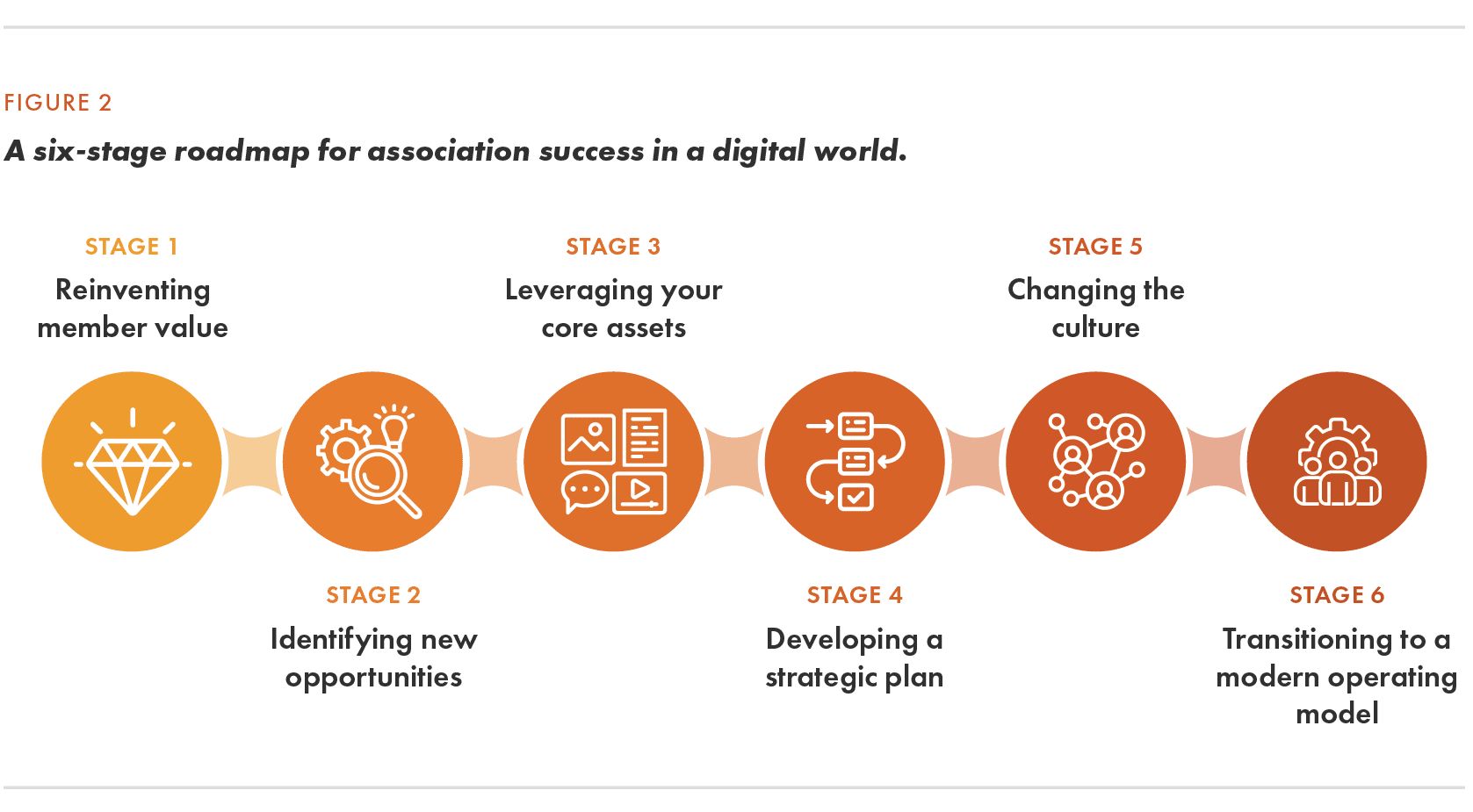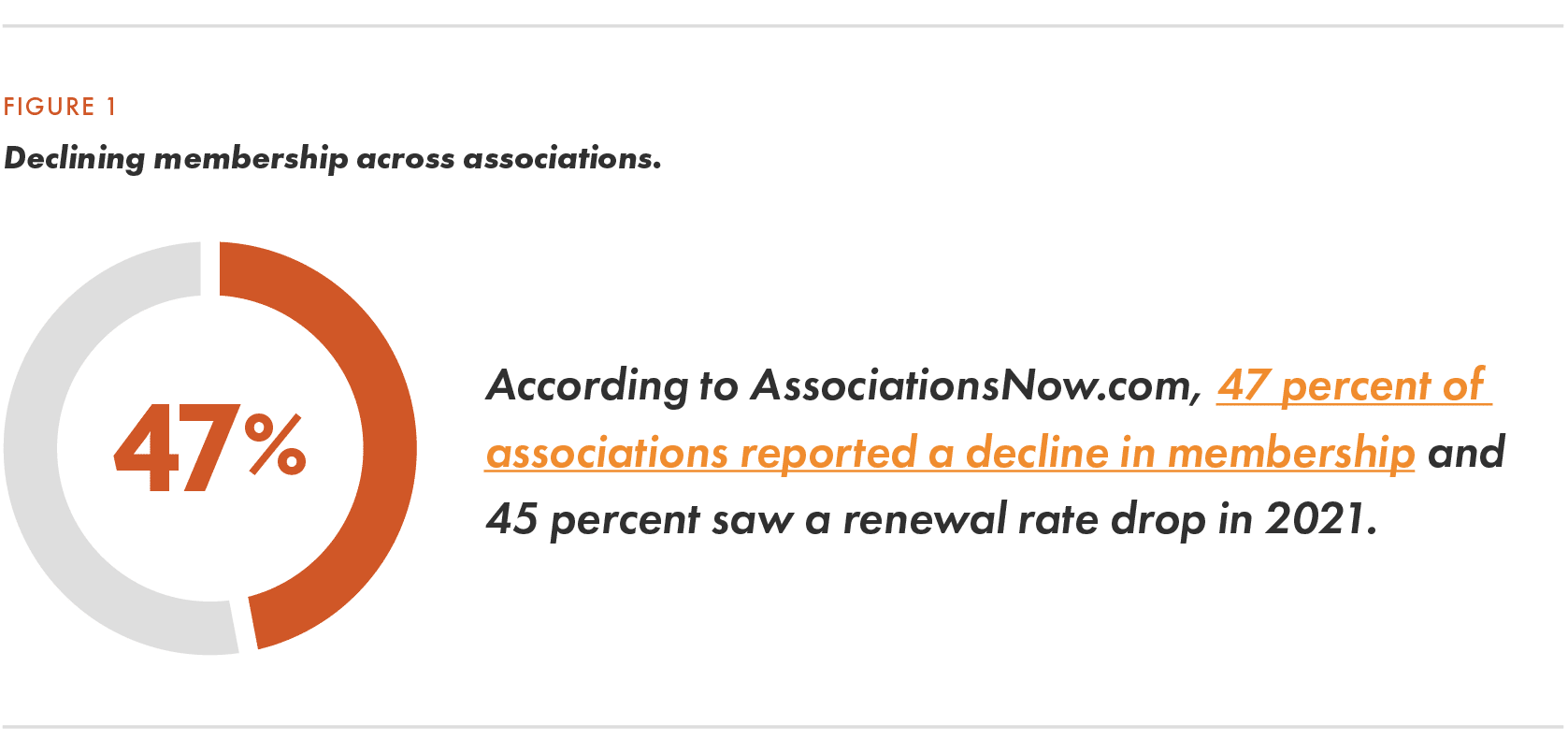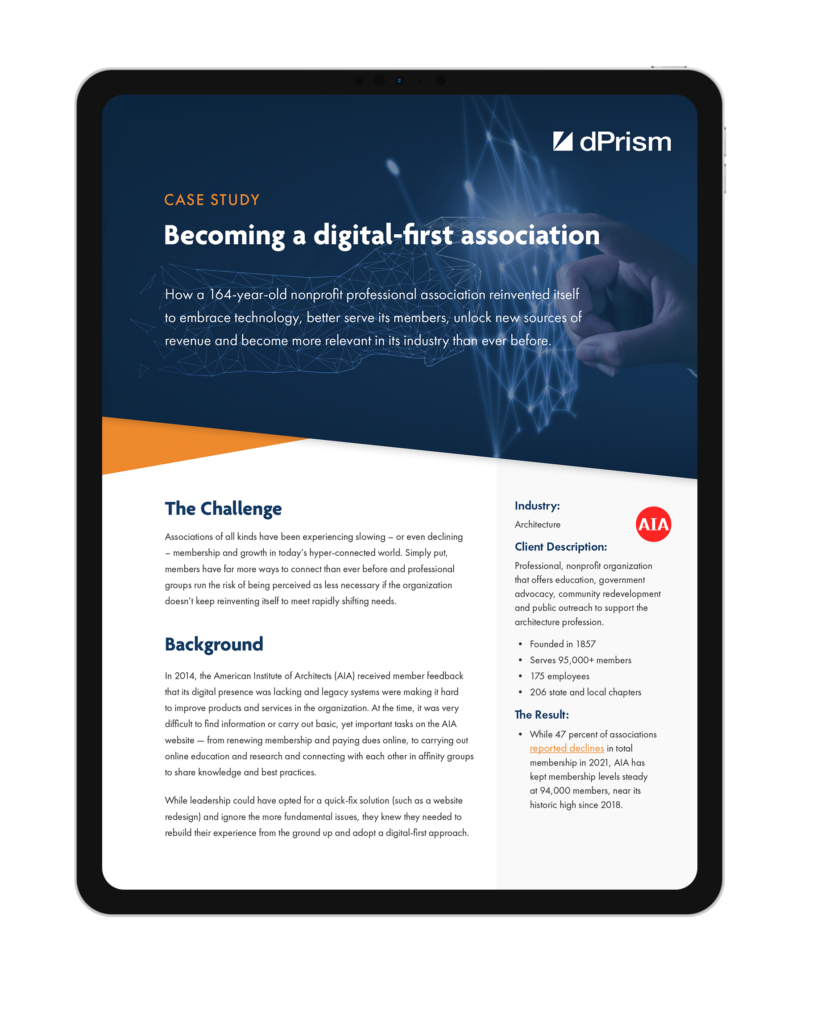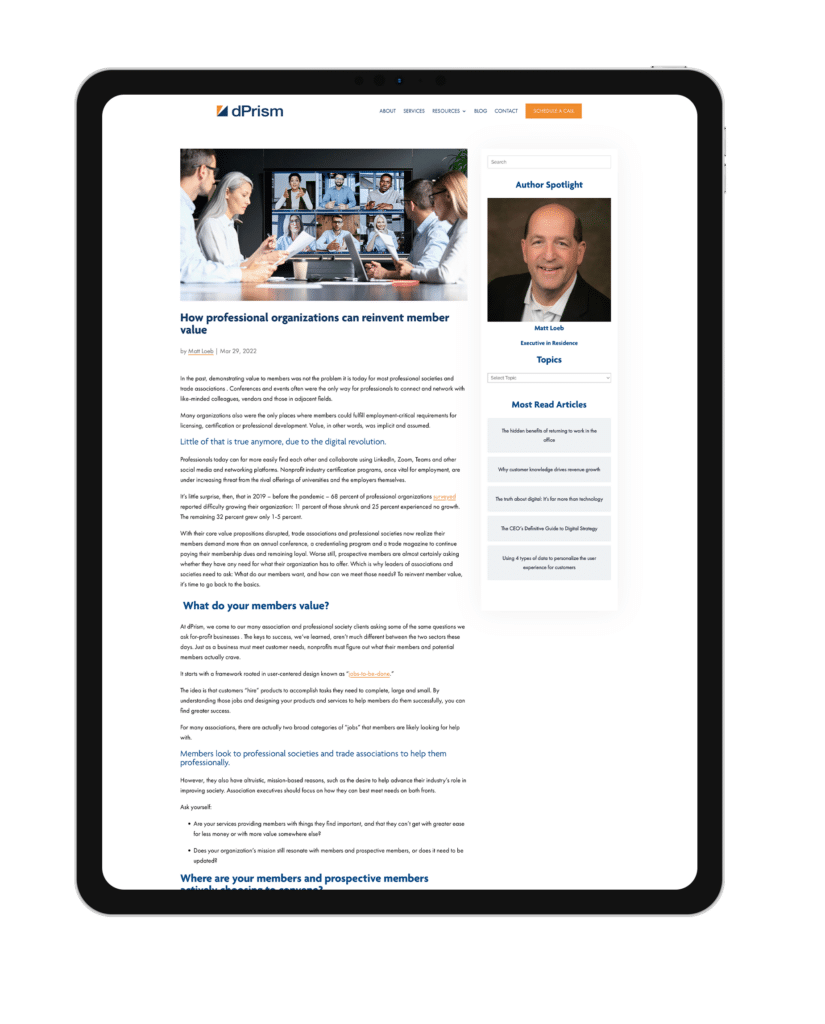Introduction
Trade and professional associations have long been essential vehicles for like-minded people and organizations to convene in the pursuit of knowledge, connection and common interests and goals. Those needs exist even as technology transforms the way people and communities organize and engage.
Today, the need for professional and trade associations remains strong. However, many are ill-equipped to survive and thrive in the modern digital world.
The reality is, membership-driven associations are facing an uncertain future due to slowly — or in many cases, declining — membership interest and growth. Many are unprepared, unwilling or unable to change and adjust in the way the members and related stakeholders need and demand.
Forward-looking association executives cannot stand still. For their organizations to survive, they must recognize and address the threats to their traditional value propositions and modernize on a range of fronts. In some ways, they need to act more like traditional, for-profit commercial businesses. In other ways, they need to embrace what makes them unique, different and special, and double down on those advantages to forge a strategic roadmap to the future.
This guide is based on Mod Op Strategic Consulting’ experience with nonprofits and associations – helping them become digital first organizations and revamping their member experience to carry them into the digital age. Because of this work, we’ve also gained exclusive insights about the industry and the opportunities for digital transformation.
Key insights and trends impacting associations include:
- Trade and professional associations no longer have a proprietary hold on
their members - For-profit companies are increasingly engaging more and more in the community-building, thought leadership, and industry-impact functions that for a long time were the exclusive domains of associations
- The “business” model of nonprofits needs to evolve, requiring their leaders to embrace data, rethink their competitive landscape, and put new energy into updating their strategic plans for long-term sustainability
And that’s just the tip of the iceberg.
In this guide, you’ll learn the six-stage roadmap for association success in a digital world, putting your nonprofit on the path to financial sustainability and growth.

By reinventing member value, identifying new opportunities, leveraging your core assets, developing a strategic plan, changing the culture and, finally, transitioning to a modern operating model, you can rediscover your best and highest value propositions — and remind your members, your industry and the world why your existence is critical, meaningful and valuable, especially during these rapidly changing times.
Stage 1: Reinventing member value
Membership organizations have traditionally justified their value by bringing like-minded professionals together to share information and ideas, collaborate, and network.
But technology, social media platforms and even for-profit companies – newly motivated to pursue societal goals like energy sustainability and diversity, equity and inclusion – have all emerged to change the competitive landscape. Members are self-organizing elsewhere, at little to no cost, often at scale and often experiencing many of the same, if not more, benefits as associations can offer.
Associations must think differently and reinvent member value. It’s critical that they’re willing and able to compete. Nonprofit leaders must understand and embrace new forms of communication and integrate them into your organization’s platforms.
Key questions to ask at this stage:
- What do your members value?
- Where are they actively choosing to convene?
- Who are you competing with for their attention?
- What can your association uniquely provide?
Annual conference, a trade magazine, or licensing and continuing education requirements used to be enough to generate interest, membership and loyalty. In earlier times association involvement served as validation that members needed to generate business or establish legitimacy.
Key insight: Does your association still have a reason to exist?
As those needs fade however, potential members are almost certainly asking whether your association still has a reason to exist. It is your job to make the answer to that question a clear
and obvious yes, by providing undeniable value to members.
Stage 2: Identifying new opportunities
If we look at the digital landscape, it’s clear that for-profits and social media platforms have siphoned away some of the traditional roles of associations. Because of this, it’s imperative to look with an open mind and a broad lens on other opportunities that may exist in the world — beyond membership dues.
To examine this, start with a market assessment that help you understand where you fit in the larger ecosystem. For nonprofits, we recommend adding a mission assessment that helps to figure out who you serve and how you serve them — and what you might be able to do to achieve your mission in new ways.
One good place to start is to remember your organization exists in a broader industry: There may be ways to bring players together and add value that you haven’t yet considered.
Membership societies in particular can tend to be so laser-focused on their member practitioners that they lose sight of adjacent industries. These adjacent industries may provide opportunities for their members to interact. It may also be a place where stakeholders find incredible value to have access to your members in a variety of ways.
Key insight: Don’t forget to look at adjacent industries for growth opportunities
As an example, many of our association clients have begun to think along these lines, providing services to vendors who come to the exhibit halls at their conferences, helping those vendors understand member needs, building programs that can connect outside vendors to their members and creating connections where none existed before.
Key questions to ask at this stage:
- Who are you well-positioned to serve beyond your core membership?
- Are there connections between industries that you are uniquely able to broker?
- What might broadening your mission enable you to achieve?
- What gaps in the market — or gaps in fulfilling your mission — has no one yet stepped up to fill?
The scope of what you can do is endless. Especially with a robust understanding of the market, this can go well beyond the conferences, publications, and traditional association services that we’re all familiar with. Technology has given us the opportunity to do so much; we need to deeply reflect on how we can best take advantage.
Stage 3: Leveraging your core assets
Nonprofits by nature are content-driven organizations.
Whether you’re producing newsletters, magazines, scholarly papers, training materials for continuing professional education or other products, content plays a key role and smart associations learn to leverage their core assets accordingly.
But in a world where everyone can be a publisher, and where technology allows for access to archival materials in a way never before possible, many associations have a huge advantage over new entrants to their market: a trove of data, information, articles and more.
Key insight: How can your association use its access to information as an advantage?
Leaders must discover how to leverage and create structures so that people can find what they’re looking for. Similarly, while content may be easy to marshal, the bottleneck may lie in the lack of systems to deliver it to the right audience in the right format at the right time.
But the assets to consider go beyond content. Associations have a privileged position in the hearts and minds of many members. They have trust relationships that allow for more information sharing and data collection, for a greater ability to broker connections and provide individual value to members, and for enhanced opportunities to embed themselves in people’s lives. It’s not just about keeping up. It’s utilizing what sets your association apart and finding breakthrough ways to impact your members.
Key questions to ask at this stage:
- What expertise do you bring to the table, and how can you best use it?
- Are there content assets that are being underutilized simply because the right systems aren’t in place?
- How can you collect useful data from members and then apply it to best serving their needs, both individually and collectively?
- How well are you engaging your community, and are there tools that would make that engagement easier?
Of course, these first three areas of exploration — member value, new opportunities and core assets — can’t be fully realized without a larger plan in place, which is where we turn next.
Stage 4: Developing a strategic plan
A well-defined strategic operating framework with clear measures and objectives becomes the guardrail that enables association executives to make sure things get done. The strategic plan of a modern, digital organization needs to be outcome-based, considering member needs and the needs of the institution, and making clear what will be done and who is accountable.
You can’t jump into this immediately. Think at the highest levels about overall strategic goals,
and then figure out how to align those goals with existing operations.
Key insight: Your plan must include what will be done and who is accountable. If you don’t have those resources in house, consider external partners.
Not everything will necessarily fit, and some programs and services may need to be redeveloped or replaced. But once things are well-aligned, the final and most difficult phase ends up being about finding the right ways to evaluate success.
Are you already operating at peak strategic form? Take some time to examine this as strategic planning for associations needs to fit and mesh within other areas of your organization.
Key questions to ask at this stage:
- Can you measure your achievements against a larger strategic plan?
- Does every member of the staff understand how their role fits into the strategy?
- Are there success measures articulated for each project or goal?
- Is the board actively engaged and involved in the planning and evaluation?
- Are you making progress, year upon year, in achieving the goals, and improving the overall organizational picture?
Stage 5: Changing the culture
While the previous stages are important, none of this can happen without a nonprofit culture change. One of the greatest disruptions facing associations is driven by the expectations of a new generation of digital-native talent and professionals entering the workforce.
User expectations, communication methods and decision-making processes are all different than they were in the past. The internal culture at a successful association needs to be centered around employees who understand shifting customer sentiments, user needs, market dynamics and how to deliver value in a digital world.
Key insight: Empower your employees to constantly evaluate member needs and market dynamics
Beyond that, employees must understand the central importance of data in decision making. Digital culture is all about rigorous analysis, and data-powered decisions. Attempting to build organizational culture without clarity around that principle will inevitably fail.
Key questions to ask at this stage:
- Have you implemented a structured strategic-planning process across all levels
of the organization? - Have you aligned staff incentive structures to the organization’s goals?
- Do you identify, reward and showcase staff actions that exhibit front-line empowerment?
Without being able to answer affirmatively to each of those questions, your association simply isn’t there yet, and attention must be paid to the employee culture before meaningful change can be achieved.
Stage 6: Transitioning to a modern operating model
All of these considerations get an association closer to what we call a modern operating model, where association executives are actively driving strategic decisions and investments that will enable their organizations to thrive.
Beyond an empowered culture driven by data-enabled decision making, organizations must also streamline operations, perhaps even using repeatable process automation (RPA), ensuring staff can focus on the highest-value activities.
Key insight: A modern operating model is not set it and forget it. It’s constant iteration and experimentation.
They also should employ experiment-driven service design to stay relevant to stakeholders, iterating constantly and looking to user needs as the building blocks of any new initiative.
Finally, it’s imperative to move to a platform-based technology strategy, demolishing the silos that hamper efficiency and usability, and ensuring data streams are consistent, connected and properly shared.
Key questions to ask at this stage:
- Have you defined and adopted a modern agile product management process and invested in appropriate staff training?
- Are you highlighting and rewarding teams that embrace iterative, experimentally driven and data-validated design and decision processes?
- Have you undertaken a full technology portfolio analysis to identify duplications and gaps in capabilities required to enable strategic framework objectives?
- Have you developed a strategic priority driven roadmap for migration, retirement or ongoing maintenance of your technology portfolio?
Getting to “Yes” on each of these highest-level questions will get your association to the apex of its journey toward success in a digital world.
Conclusion and next steps
We hope this guide has provided you with valuable information and insight to help you evaluate and modernize your association’s thinking to make the digital leap.
With decades of experience getting nonprofits to the next level, our team at Mod Op Strategic Consulting are experts at helping you carry out your mission in today’s complex landscape while bringing a fresh perspective to the journey.
To learn more, visit our website at Mod Op Strategic Consulting.com or reach out for a free call with one of our association consultants.







